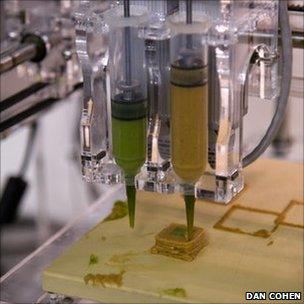The printed future of Christmas dinner
- Published

Christmas dinner traditionally centres on the turkey or goose. But if US scientists have their way, everyone may be sitting around a printer.
The team at Cornell University's Computational Synthesis Lab (CCSL) are building a 3D food printer, as part of the bigger Fab@home project, which they hope one day will be as commonplace as the microwave oven or blender.
Just pop the raw food "inks" in the top, load the recipe - or 'FabApp' - and the machine would do the rest.
"FabApps would allow you to tweak your foods taste, texture and other properties," says Dr Jeffrey Ian Lipton, who leads the project.
"Maybe you really love biscuits, but want them extra flaky. You would change the slider and the recipe and the instructions would adjust accordingly."
The goal is to blow the lid off cooking as we know it and change the future of food production.
People lacking even basic culinary skills could download the recipe files of master chefs or print out nutrition-packed dishes recommended by their doctors.
Chefs could also create new foodstuffs and customizable menus for fussy customers.
And it would have the added benefit of cutting out some of the waste of current food production methods, says Homaro Cantu, chef and owner of the Moto Restaurant in Chicago, Illinois, who has printed sushi using an ink jet printer.
"Imagine being able to essentially 'grow', 'cook' or prepare foods without the negative industrial impact - everything from fertilizers to saute pans and even packaging," he says.
"The production chain requirements for food would nearly be eliminated."
Local food, could really mean local.
"You can imagine a 3D printer making homemade apple pie without the need for farming the apples, fertilizing, transporting, refrigerating, packaging, fabricating, cooking, serving and the need for all of the materials in these processes like cars, trucks, pans, coolers, etc," he adds.
'Designer domes'
While other researchers have toyed with the idea of printing food - notably at the Massachusetts Institute of Technology - the Fab@home team is actively working on creating an affordable syringe-based 3D printer that can print a wide variety of foods.
The current design is basically a series of precise syringes that deposits food inks line by line, and layer by layer, according to an electronic blueprint.
The blueprint specifies exactly what materials go where and are currently drawn up using traditional engineering computer aided design (CAD) software.
"In the future there would probably be a kind of 'ChefCAD' that will allow people to design their own food constructions," said Professor Hod Lipson, Director of CCSL.
"You'd hit the print button and it would ask you how many copies," said Prof Lipson.
The raw materials used to print the food are currently limited to anything that can be extruded from a syringe. Commonly they are liquid or melted versions of ingredients, including chocolate, cookie dough, cheese, or cake batter.
However, the team are now experimenting with mixing foods with hydrocolloids - substances that form gels with water, generally used to thicken food products - to create a range of basic liquid ingredients.
They also recognize that people will want to create their own inks, allowing everyone to become Willy Wonka.
This creates its own problems.
"Each material will behave differently," says Dr Lipton.
The solution would be to create a machine that constantly examines what it is printing, tweaking the design and mixture of raw ingredients as it goes.
"I feel like both approaches will be used going forward," he says. "In situations where you want complete control over the food intact and properties - hospitals, space flight, personal dieting - people will use the hydrocolloids approach.
When doing home cooking you want to be able to use your own hand-made ingredients and feedback will be the only solution."
The team has already had some success with their prototypes, creating cookies with embedded letters and designer domes made of turkey meat.
They hope to make their designs and ingredients list more complex, and able to handle food that people want to eat.
"Imagine if the microwave oven worked only with frozen pre cooked hot dogs when it first came out - no one would have them now," says Dr Lipton.
Long-term, the team believes that people will take to the technology by creating their own 3D printable food recipe social networks with everyone improving on each other's creations.
"3D printing will do for food what e-mail and instant messaging did for communication," says Mr Cantu.
"What if you could have mom's homemade apple pie sent via e-mail and printed up at home? Her apple pie becomes as close as an instant message on Facebook."
- Published25 November 2010
- Published22 December 2010
- Published30 April 2010
- Published6 August 2003